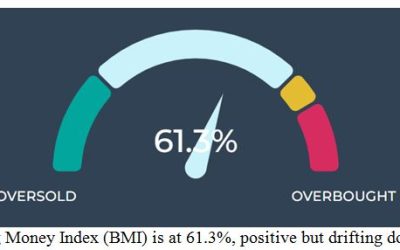by Ivan Martchev
September 9, 2025
I have explained Bollinger bands before. They are a type of statistical indicator that places two bands – each measuring two standard deviations – around a 20-day moving average. The wider the bands are, the more volatile the stock market is, while the narrower the bands are, the less volatile the market is.
If I’d tell you, or any investor, that the width of the Bollinger bands is now the tightest since February – meaning that the stock market is not very volatile – you might look at me like I was from a different planet. This is because the stock market has been flipping up and down like a fish out of water for the past three-weeks, while also managing to register a few marginal new all-time highs in the process.
Graphs are for illustrative and discussion purposes only. Please read important disclosures at the end of this commentary.
One conclusion I draw from this chart is that the stock market is struggling to make progress, and new highs are being met with new sellers. This is how the stock market was acting in February, just before the correction which the President turned into a full-fledged bear market with his aggressive tariff policy.
As I’ve written here before, I think that the successful conclusion of this trade war is necessary after decades of bad trade policy, but at now appears that the Trump tariffs are going all the way to the Supreme Court and we can’t be sure which way they will decide, despite a Republican majority there.
Since this record-breaking rally started in earnest in late April, there have been only three closes below the 20-day moving average (the middle Bollinger Band), which is to say this rally has been very strong.
As I have noted here before, the way to know if a correction has started in earnest is for the market to begin trending lower – that is, below its middle Bollinger Band (the 20-day moving average). The last such close was last Tuesday (the first trading day of September), and the low that day was 6,360. So, if you see the S&P 500 register several daily closes below 6,360, that would anticipate a better-than-even chance that a normal correction has started. My guess of where that correction can go is to 5,900, give or take 2%, which is the vicinity of the S&P 500’s 200-day moving average. That would be “normal.”
For things to work out in a more benign manner, it would be very important for the economic data to hold up. There was disappointment with the weak employment report that came out last Friday, as non-farm payrolls rose by only 22k, even though that looks more like a pause in hiring than losing jobs.
Weekly Jobless Claims Have Been in a Long, Low Plateau Since 2022
Graphs are for illustrative and discussion purposes only. Please read important disclosures at the end of this commentary.
Due to the high level of uncertainty in the President’s “tariffs on-tariffs off” strategy, the most natural thing that companies can now do is hit the pause button on hiring until the smoke clears. Still, there are no signs of job losses in the weekly jobless claims chart (above). To be in a recession mode, weekly jobless claims need to consistently stay above 350,000 and get over 400k. Since weekly jobless claims declined below 300k after they began to normalize after COVID, they have never been above that level, but given the weak payroll report and negative revisions that cost the BLS commissioner her job, I think the weekly jobless claims will become more important as an indicator to watch between now and the end of the year.
Another sign of a coming correction is that Nvidia (NVDA), the largest company in the stock market by market cap, recently hit an all-time high, with a market cap reaching $4.4-trillion. Nvidia reported great earnings, but there was no outlook for Chinese sales as they have become highly political (export licenses by the U.S. that cost 15% of sales and the desire of the Chinese to have home grown AI chips). Nvidia is correcting some, which would be normal after more than doubling off its April lows. I believe a good target for a correction is the $140-$150 range, which is the vicinity of the prior all-time highs that held for a while.
Graphs are for illustrative and discussion purposes only. Please read important disclosures at the end of this commentary.
Because it is the largest company on the big board, the world could use Nvidia as a stock market indicator itself. The correction in Nvidia is a function of money flowing out of the technology sector into the broad market, which is healthy from an intermediate-term perspective, but it could fuel an S&P 500 correction.
The S&P 500 has become a very lopsided index. The top 10-companies in the index make up 40% of the value of the index while the other 490-stocks reflect only 60% of the index’s value. Of the top 10-stocks, eight are in the technology sector. If money is going out of the tech sector to the other 490-components of the index, that would be a healthy development, but one that is unlikely to go completely smoothly.
As things stand right now, 5900 (give or take 2%) is a good target for a correction, while 7,000 remains my base-case scenario of a year-end target – but only if the economic numbers continue to hold up.
Navellier & Associates; own NVidia (NVDA) in managed accounts. Ivan Martchev does not personally own NVidia (NVDA).
The post 9-9-25: What September’s Low Market Volatility Means appeared first on Navellier.








